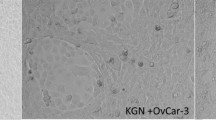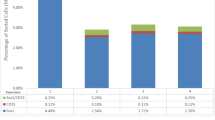Summary
Mammalian ovarian surface epithelial (OSE) cells and peritoneal mesothelial (PM) cells have a common embryologic origin, yet certain morphologic and histochemical characteristics are different in the adult. In this study, a two-step culture method was developed to examine the characteristics of these two cell types in vitro. OSE, PM, and ovarian granulosa (GC) cells were isolated from estrous rabbits and cultured for 6 d in 5% serum-supplementedd-valine medium (to inhibit fibroblast growth), then incubated for a further 2 d in serum-free McCoy's 5A medium. This study showed that rabbit OSE and PM cells in vitro maintained certain in vivo morphologic characteristics; OSE cells exhibited distinct cell borders and abundant microvilli of homogeneous size and shape, whereas PM cells were characterized by obscure cell borders and abundant microvilli of heterogeneous form. GC in vitro exhibited overlapping cell borders and sparse microvilli of homogeneous structure. This study showed for the first time that cultured rabbit OSE and PM cells, but not GC, contain distinct filaments of cytokeratin 18. In addition, rabbit OSE cells and GC, but not PM cells, contained 17β-hydroxysteroid dehydrogenase. However, only GC contained delta 5-3β hydroxysteroid dehydrogenase. OSE, PM, and GC maintained their ultrastructural and histochemical characteristics in serum-free medium. These results suggest that rabbit OSE cells in vitro could be distinguished from PM cells by histochemical and ultrastructural differences. Furthermore, because these characteristics were not altered in serum-free medium, the two-step culture method will be valuable in further hormonal studies of these cells in vitro.
Similar content being viewed by others
References
Scully, R. E. Ovarian tumors—a review. Am. J. Pathol. 87:686–720; 1977.
Falkson, C. I. Mesothelioma or ovarian cancer? S. Afr. Med. J. 68:676–677; 1985.
Parmley, T. H.; Woodruff, J. D. The ovarian mesothelioma. Am. J. Obstet. Gynecol. 120:234–241; 1974.
Foyle, A.; Al-Jabi, M.; McCaughey, W. T. E. Papillary peritoneal tumors in women. Am. J. Surg. Pathol. 5:241–249, 1981.
Genadry, R.; Poliakoff, S.; Rotmensch, J., et al. Primary, papillary peritoneal neoplasia. Obstet. Gynecol. 58:730–734; 1981.
Swerdlow, M. Mesothelioma of the pelvic peritoneum resembling papillary cystadenocarcinoma of ovary. Am. J. Obstet. Gynecol. 77:197–200; 1959.
Julian, C. G.; Goss, J.; Blanchard K., et al. Biological behaviour of primary ovarian malignancy. Obstet. Gynecol. 44:873–884; 1974.
Blaustein, A. Peritoneal mesothelium and ovarian surface cells-shared characteristics. Int. J. Gynecol. Pathol. 3:361–375; 1984.
Blaustein, A. U.; Lee, H. Surface cells of the ovary and pelvic peritoneum. A histochemical and ultrastructural comparison. Gynecol. Oncol. 8:34–43; 1979.
Hoang-Noc, M.; Smadja, A.; Orcel, L. Etude morphologique comparée du mésothélium péritonéal et de l'épithélium germinatif de l'ovaire. J. Gynecol. Obstet. Biol. Reprod. 17:479–484; 1988.
Nicosia, S. V.; Johnson, J. H. Surface morphology of ovarian mesothelium (surface epithelium) and of other pelvic and extrapelvic mesothelial sites in the rabbit. Int. J. Gynecol. Pathol. 3:249–260; 1984.
Klein, B.; Falkson, G. Ovarian cancer. S. Afr. Cancer. Bull. 27:140–145; 1983.
Lerner, H. J.; Schoenfeld, D. A.; Martin, A., et al. Malignant mesothelioma: ECOG experience. Cancer 52:1981–1985; 1983.
Kannerstein, M.; Churg, J.; McCaughey, W. T. E., et al. Papillary tumors of the peritoneum in women; mesothelioma or papillary carcinoma. Am. J. Obstet. Gynecol. 127:306–314; 1977.
Hamilton, T. C.; henderson, W. J.; Eaton, C. Isolation and growth of the rat ovarian germinal epithelium. In: Richards, R. J.; Rajan, K. T., eds. Tissue culture in medical research, II: proceedings of 2nd international symposium. New York: Pergamon Press. 1980:237–244.
Adams, A. T.; Auersperg, N. Transformation of cultured rat ovarian surface epithelium cells by kirsten murine sarcoma virus. Cancer Res 41:2063–2072; 1981.
Auersperg, N.; Siemens, C. H.; Myrdal, S. E. Human ovarian surface epithelium in primary culture. In Vitro 20:743–755; 1984.
Nicosia, S. V.; Johnson, J. H.; Streibel, E. J. Isolation and ultrastructure of rabbit ovarian mesothelium (surface epithelium). Int. J. Gynecol. Pathol. 3:348–360; 1984.
Nicholson, L. J.; Clark, J. M. F.; Pittilo R. M., et al. The mesothelial cell as a nonthrombogenic surface. Thromb. Haemostasis. 52:2511–2514; 1984.
Gilbert, S. F.; Migeon, B. R.d-Valine as a selective agent for normal human and rodent epithelial cells in culture. Cell 5:11–17; 1975.
Spurr, A. R. A low-viscosity epoxy resin embedding medium for electron microscopy. J. Ultrastruct. Res. 26:31–43; 1969.
Gamliel, H. Optimum fixation conditions may allow air drying of soft biological specimens with minimum cell shrinkage and maximum preservation of surface features. Scan. Electron. Microsc. (Pt. 4):1649–1664; 1985.
Tölle, H.-G.; Weber, K.; Osborn, M., Microinjection of monoclonal antibodies specific for one intermediate filament protein in cells containing multiple keratins allow insight into the composition of particular 10 nm filaments. Eur. J. Cell Biol. 38:234–244; 1985.
Levy, H.; Deane, H. W.; Rubin, B. L. Visualization of steroid-3β-Ol-dehydrogenase activity in tissue of intact and hypophysectomized rats. Endocrinology 65:932–943; 1959.
Anderson, E.; Selig, M.; Lee, G., et al. Androgen-induced changes in ovarian granulosa cells from immature ratsin vitro. In: Mahesh, V. B.; Dhindsa, D. S.; Anderson, E. et al. eds. Regulation of ovarian and testicular function. New York: Plenum Press. 1987:259–274.
Stein, K.; Allen, E. Attempts to stimulate proliferation of the germinal epithelium of the ovary. Anat. Rec. 82:1–9; 1942.
Hamilton, T. C.; Davies, P.; Griffiths, K. Androgen and estrogen binding in cytosols of human ovarian tumours. J. Endocrinol. 90:421–431; 1981.
Hamilton, T. C.; Davies, P.; Griffiths, K. Oestrogen receptor-like binding in the surface germinal epithelium of the rat ovary. J. Endocrinol. 95:377–385; 1982.
Adams, A. T.; Auersperg, N. Autoradiographic investigation of estrogen binding in cultured rat ovarian surface epithelial cells. J. Histochem. Cytochem. 31:1321–1325; 1983.
Simon, W. E.; Albrecht, M.; Hansel, M. et al. Cell lines derived from human ovarian carcinomas: growth stimulation by gonadotropin and steroid hormones. JNCI 70:839–844; 1983.
Osterholzer, H. O.; Streibel, E. J.; Nicosia, S. V. Growth effects of protein hormones on cultured rabbit ovarian surface epithelial cells. Biol. Reprod. 33:247–258; 1985.
Rajaniemi, H.; Kauppila, A.; Ronnberg, L., et al. LH (hCG) receptor in benign and malignant tumors of human ovary. Acta Obstet. Gynecol. Scand. Suppl. 101:83–86; 1981.
Cramer, D. W.; Hutchison, G. B.; Welch, W. R., et al. Factors affecting the association of oral contraceptives and ovarian cancer. N. Engl. J. Med. 307:1047–1051; 1982.
Resta, L.; De Benedictis, G.; Scordari, M. D., et al. Hyperplasia and metaplasia of ovarian surface epithelium in women with endometrial carcinoma. Suggestion for a hormonal influence in ovarian carcinogenesis. Tumori 73:249–256; 1987.
Schwartz, N. B. The role of FSH and LH and of their antibodies on follicle growth and on ovulation. Biol. Reprod. 10:236–272; 1974.
Channing, C. P.; Tsafriri, A. Mechanism of action of luteinizing hormone and follicle-stimulating hormone on the ovaryin vitro. Metabolism 26:413–468; 1977.
Fathalla, M. F. Incessant ovulation—a factor in ovarian neoplasm? Lancet 2:163; 1971.
Zajicek, J. Ovarian cystomas and ovulations, a histogenetic concept. Tumori 63:429–435; 1977.
Osterholzer, H. O.; Johnson, J. E.; Nicosia, S. V. An autoradiographic study of rabbit ovarian surface epithelium before and after ovulation. Biol. Reprod. 33:729–738; 1985.
Siemens, C.; Auersperg N. Serial propagation of human ovarian surface epithelium in tissue culture. J. Cell. Physiol. 134:347–356; 1988.
Piquette, G. N.; Timms, B. G. Immunohistochemical localization of tissue-type plasminogen activator (t-PA) in primary cultures of rabbit ovarian surface epithelium, granulosa cells, and peritoneal mesothelium. Biol. Reprod. 38(Suppl. 1:Abs) 405; 1988.
Author information
Authors and Affiliations
Additional information
This work was supported in part by Grant No. 202-3192 from the University of South Dakota Parsons Fund
Rights and permissions
About this article
Cite this article
Piquette, G.N., timms, B.G. Isolation and characterization of rabbit ovarian surface epithelium, granulosa cells, and peritoneal mesothelium in primary culture. In Vitro Cell Dev Biol 26, 471–481 (1990). https://doi.org/10.1007/BF02624089
Received:
Accepted:
Issue Date:
DOI: https://doi.org/10.1007/BF02624089




